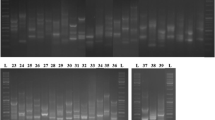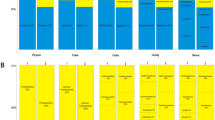Abstract
The aim of this study was to isolate and characterize endophytic bacteria from roots, stems and leaves of Zn/Cd hyperaccumulator Sedum alfredii. Endophytic bacteria were observed in roots, stems and leave of S. alfredii, with a significantly higher density in roots, followed by leave and stems. A total of fourteen bacterial endophytes were isolated and are closely related phylogenetically to Pseudomonas, Bacillus, Stenotrophomonas, Acinetobacte by 16S rRNA sequence analysis. Most of the endophytic bacteria were found to exhibit high Zn and Cd resistance characteristics, but difference existed among this isolates. The fourteen endophytic bacteria all had the capacity to produce IAA. Moreover, strains VI8L1, VI8L2, VI8L4, VI8R2, VI8R3 and II2R3 could solubilize Ca3(PO4)2, strains VI8L2, II8L4 and VI8R2 could produce siderophore, and strains VI8L2 and VI8R3 had the capacity of nitrogen fixation. Both plate and broth assay proved that strain VI8L1, VI8L2, II8L4 and VI8R2 were able to effectively solubilize ZnCO3 and Zn3(PO4)2. The filtrate liquid media after growth of strains VI8L1, VI8L2, II8L4 and VI8R2 extracted much higher Zn from artificially ZnCO3 and Zn3(PO4)2 contaminated soils than those extracted by axenic SMS broth, and the filtrates of the culture media supporting growth of strains VI8L2, II8L4 and VI8R2 also extracted significantly greater quantities of Zn from the Dabaoshan contaminated soils. This Zn mobilizing, plant growth promoting and metal resistant endophytic bacteria may offer promise as inoculants to increase soil Zn bioavailability and improve growth and Zn accumulation by S. alfredii.




Similar content being viewed by others
References
Abou-Shanab RAI, Angle JS, Delorme TA, Chaney RL, van Berkum P, Moawad H, Ghanem K, Ghozlan HA (2003a) Rhizobacterial effects on nickel extraction from soil and uptake by Alyssum murale. New Phytol 158:219–224
Abou-Shanab RAI, Delorme TA, Angle JS, Chaney RL, Ghanem K, Moawad H, Ghozlan HA (2003b) Phenotypic characterization of microbes in the rhizosphere of Alyssum murale. Int J Phytoremediation 5:367–379
Adriano DC (2001) Trace elements in terrestrial environments: biogeochemistry. Bioavailability and risks of metals. Springer, New York
Baker AJM, McGrath SP, Reeves R, Smith JAC (2000) Metal hyperaccumulator plants: a review of the ecology and physiology of a biological resource for phytoremediation of metal-polluted soils. In: Terry N, Bañuelos G (eds) Phytoremediation of contaminated soil and water. Lewis Publishers, Boca Raton, pp 85–107
Barzanti R, Ozino F, Bazzicalupo M, Gabbrielli R, Galardi CG, Mengoni A (2007) Isolation and characterization of endophytic bacteria from the nickel hyperaccumulator plant Alyssum bertolonii. J Microbial Ecol 53:306–316
Compant S, Duffy B, Nowak J, Barka EA (2005a) Use of plant growth-promoting bacteria for biocontrol of plant diseases: principles, mechanisms of action, and future prospects. Appl Environ Microbiol 71:4951–4959
Compant S, Reiter B, Sessitsch A, Nowak J, Clément C, Barka EA (2005b) Endophytic colonization of Vitis vinifera L. by a plant growth-promoting bacterium, Burkholderia sp. Strain PsJN. Appl Environ Microbiol 71:1685–1693
Costa JM, Loper JE (1994) Characterization of siderophore production by the biological-control agent Enterobacter cloacae. Mol Plant Microbe Interact 7:440–448
Di Fiori S, Del Gallo M (1995) Endophytic bacteria: their possible role in the host plant. In: Fendrik I, del Gallo M, Vanderleyden J, Zamoroczy M (eds) Azospirillum VI and related microorganisms. Springer, Berlin, pp 169–188
Dong XZ, Cai MY (2001) Manual of systematic methods of determinative bacteriology. Science Press, China
Franz A, Burgstaller W, Schinner F (1991) Leaching with Penicillium simplicissimum: influence on metals and buffers on proton extrusion and citric acid production. Appl Environ Microbiol 57:769–774
Glick BR, Patten CL, Holguin G, Penrose GM (1999) Biochemical and genetic mechanisms used by plant growth promoting bacteria. Imperial College Press, London
Idris R, Trifonova R, Puschenreiter M, Welzel WW, Seissitsch A (2004) Bacterial communities associated with flowering plants of the Ni hyperaccumulator Thlaspi goesingense. Appl Environ Microbiol 70:2667–2677
Idris R, Kuffner M, Bodrossy L, Puschenreiter M, Monchy S, Welzel WW, Seissitsch A (2006) Characterization of Ni-tolerant methylobacteria associated with the hyperaccumulating plant Thlaspi goesingense and description of Methylobacterium goesingense sp. nov. Syst Appl Microbiol 29:634–644
Jiang YC (2005) Screening of heavy-resistant strains and their biological characteristics and effects on the phytoremediation of soil contaminated with lead and cadmium. Master's dissertation, Nanjing Agricultural University, Nanjing, China (in Chinese)
Lee S, Flores-Encarnacion M, Contreras-Zentella M, Garcia-Flores L, Escamilla JE, Kennedy C (2004) Indole-3-acetic acid biosynthesis is deficient in Gluconacetobacter diazotrophicus strains with mutations in cytochrome C biogenesis genes. J Bacteriol 186:5384–5391
Libbert E, Kaiser W, Kunert R (2006) Interactions between plants and epiphytic bacteria regarding their auxin metabolism VI. The influence of the epiphytic bacteria on the content of extractable auxin in the Plant. Physiol Plant 22:432–439
Lodewyckx C, Taghavi S, Mergeay M, Vangronsveld J, Clijsters H, van der Lelie D (2001) The effect of recombinant heavy metal-resistant endophytic bacteria on heavy metal uptake by their host plant. Int J Phytoremediat 3:173–187
Lodewyckx C, Mergeay M, Vangronsveld J, Clijsters H, van der Lelie D (2002) Isolation, characterization, and identification of bacteria assolciated with the zinc hyperaccumulator Thlaspi caerulescens subsp. calaminaria. Int J Phytoremediation 4:101–115
Long XX, Yang XE, Ye ZQ, Ni WZ, Shi WY (2002) Differences of uptake and accumulation of zinc in four species of Sedum. Acta Bot Sin 44:152–157
Mastretta C, Barac T, Vangronsveld J, Newman L, Taghavi S, van der Lelie D (2006) Endophytic bacteria and their potential application to improve the phytoremediation of contaminated environments. J Biotechnol Genetic Eng Rev 23:175–207
Mastretta C, Taghavi S, van der Lelie D, Mengoni A, Galardi F, Gonnelli C, Barac T, Boulet J, Weyens N, Vangronsveld J (2009) Endophytic bacteria from seeds of Nicotiana tabacum can reduce cadmium phytotoxicity. Int J Phytoremediation 11:251–267
McGrath SP, Zhao FJ (2003) Phytoextraction of metals and metalloids from contaminated soils. Curr Opin Biotechnol 14:277–282
Pirttilä AM, Joensuu P, Pospiech H, Jalonen J, Hohtola A (2004) Bud endophytes of Scots pine produce adenine derivatives and other compounds that affect morphology and mitigate browning of callus cultures. Physiol Plant 121:305–312
Rajkumar M, Noriharu A, Hhlena F (2009) Endophytic bacterial and their potential to enhance heavy metal phytoextraction. Chemosphere 77:153–160
Ryan RP, Germaine K, Franks A, Ryan DJ, Dowling DN (2008) Bacterial endophytes: recent developments and applications. FEMS Microbiol Lett 278:1–9
Salt DE, Smith RD, Raskin I (1998) Phytoremediation. Annu Rev Plant Physiol Plant Mol Biol 49:643–668
Saravanan VS, Kalaiarasan P, Madhaiyan M, Thangarju M (2007) Solubilization of insoluble zinc compounds by Gluconacetobacter diazotrophicus and the detrimental action of zinc ion (Zn2+) and zinc chelates on root knot nematode Meloidogyne incognita. Lett Appl Microbiol 44:235–241
Schwyn B, Neilands JB (1987) Universal chemical assay for the detection and determination of siderophores. Anal Biochem 160:47–56
Sheng XF, Xia JJ (2006) Improvement of rape (Brassica napus) plant growth and cadmium uptake by cadmium-resistant bacteria. Chemosphere 64:1036–1042
Sheng XF, He LY, Wang Q, Ye H, Jiang C (2008) Effects of inoculation of biosurfactant-producing Bacillus sp. J119 on plant growth and cadmium uptake in a cadmium-amended soil. J Hazard Mater 155:17–22
Sun YB, Zhou QX, Wang L, Liu WT (2009) Cadmium tolerance and accumulation characteristics of Bidens pilosa L. as a potential Cd-hyperaccumulator. J Hazard Mater 161:808–814
Verma SC, Ladha JK, Tripathi AK (2001) Evaluation of plant growth promoting and colonization ability of endophytic diazotrophs from deep water rice. J Biotechnol 91:127–141
Wakeli S, Warren R, Harvey P, Ryder M (2004) Phosphate solubilization by Penicillium spp. closely associated with wheat roots. Biol Fertil Soils 40:36–43
Wu SC, Cheung KC, Luo YM, Wong MH (2006) Effects of inoculation of plant growth-promoting rhizobacteria on metal uptake by Brassica juncea. Environ Pollut 140:124–135
Yang XE, Long XX, Ye HB, He ZL, Calvert DV, Stoffella PJ (2004) Cadmium tolerance and hyperaccumulation in a new Zn-hyperaccumulating plant species (Sedum alfredii Hance). Plant Soil 259:181–189
Zhou JL (2009) Chelator-enhanced phytoremediation of lead-zinc mining wastewater contaminated soils and associated possible leaching risk. Doctoral dissertation, South China Agricultural University, Guangzhou, China (in Chinese)
Acknowledgments
This research was supported by Chinese National Natural Science Foundation (No.40973055, No.40801115) and the NFS-Guangdong Joint Fund Key Projects (No. U0833004).
Author information
Authors and Affiliations
Corresponding author
Rights and permissions
About this article
Cite this article
Xinxian, L., Xuemei, C., Yagang, C. et al. Isolation and characterization endophytic bacteria from hyperaccumulator Sedum alfredii Hance and their potential to promote phytoextraction of zinc polluted soil. World J Microbiol Biotechnol 27, 1197–1207 (2011). https://doi.org/10.1007/s11274-010-0568-3
Received:
Accepted:
Published:
Issue Date:
DOI: https://doi.org/10.1007/s11274-010-0568-3




